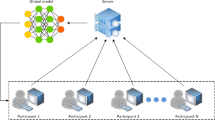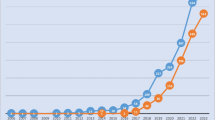Abstract
Big data has reignited research interest in machine learning. Massive quantities of data are being generated regularly as a consequence of the development in the Internet, social networks, and online sensors. Particularly deep neural networks benefited greatly from this unprecedented data availability. Large models with millions of parameters are becoming common, and big data has been proved to be essential for their effective training. The scientific community has come up with a number of methods to create more accurate models, but most of these methods require high-performance infrastructure. There is also the issue of privacy, since anyone using leased processing power from a remote data center is putting their data in the hands of a third party. Studies on decentralized and non-binding methods among individuals with commodity hardware are scarce, though. Our work on LEARNAE seeks to respond to this challenge by creating a totally distributed and fault-tolerant framework of artificial neural network training. In our recent work, we demonstrated a method for incentivizing peers to participate to collaborative process, even if they are not interested in the neural network produced. For this, LEARNAE included a subsystem that rewards participants proportionately to their contribution using digital assets. In this article we add another important piece to the puzzle: A decentralized mechanism to mitigate the effect of bad actors, such as nodes that attempt to exploit LEARNAE’s network power without following the established rewarding rules. This is achieved by a novel reward mechanism, which takes into account the overall contribution of each node to the entire swarm. The network collaboratively builds a contribution profile for every participant, and the final rewards are dictated by these profiles. Taking for granted that the majority of the peers are benevolent, the whole process is tamper-proof, since it is implemented on blockchain and thus is protected by distributed consensus. All codebase is structured as a decentralized autonomous organization, which allows LEARNAE to embed new features like digital asset locking, proposal submitting, and voting.










Similar content being viewed by others
References
Nikolaidis S, Refanidis I (2019) Learnae: distributed and resilient deep neural network training for heterogeneous peer to peer topologies. Eng Appl Neural Netw 25:286–298. https://doi.org/10.1007/978-3-030-20257-6_24
Nikolaidis S, Refanidis I (2020) Privacy preserving distributed training of neural networks. Neural Comput Applic 32(23):17333–17350. https://doi.org/10.1007/s00521-020-04880-0
Nikolaidis S, Refanidis I (2021) Using distributed ledger technology to democratize neural network training. Appl Intell. https://doi.org/10.1007/s10489-021-02340-3
Benet J (2021) “IPFS - Content addressed, versioned, P2P file system,” [cs], Jul. 2014, Accessed: Apr. 01, [Online]. Available: http://arxiv.org/abs/1407.3561
Popov S, Saa O, Finardi P (2019) Equilibria in the Tangle. Comput Ind Eng 136:160–172. https://doi.org/10.1016/j.cie.2019.07.025
Zhang X, Trmal J, Povey D, and Khudanpur S (2014) “Improving deep neural network acoustic models using generalized maxout networks,” in 2014 IEEE International conference on acoustics, speech and signal processing (ICASSP), , pp. 215–219. doi: https://doi.org/10.1109/ICASSP.2014.6853589
Miao Y, Zhang H, and Metze F (2014) Distributed learning of multilingual dnn feature extractors using gpus
Dean J et al (2021) “Large scale distributed deep networks,” in advances in neural information processing systems, 2012, vol. 25. Accessed: Aug. 11, [Online]. Available: https://papers.nips.cc/paper/2012/hash/6aca97005c68f1206823815f66102863-Abstract.html
Mashtizadeh AJ, Bittau A, Huang YF, and Mazières D (2013) “Replication, history, and grafting in the Ori file system,” in Proceedings of the twenty-fourth ACM symposium on operating systems principles, New York, NY, USA, pp. 151–166. https://doi.org/10.1145/2517349.2522721
Cohen B (2003) “Incentives build robustness in BitTorrent,” Workshop on Economics of PeertoPeer systems, vol. 6
Baumgart I and Mies S (2007) “S/Kademlia: A practicable approach towards secure key-based routing,” in 2007 International conference on parallel and distributed systems, pp. 1–8. https://doi.org/10.1109/ICPADS.2007.4447808
Freedman MJ, Freudenthal E, and Mazières D (2004) “Democratizing content publication with coral,” in Proceedings of the 1st conference on symposium on networked systems design and implementation - Volume 1, USA, p. 18
Wang L and Kangasharju J (2013) “Measuring large-scale distributed systems: case of bittorrent mainline DHT,” presented at the IEEE International conference on peer-to-peer computing,. https://doi.org/10.1109/P2P.2013.6688697
Nofer M, Gomber P, Hinz O et al (2017) Blockchain. Bus Inf Syst Eng 59:183–187. https://doi.org/10.1007/s12599-017-0467-3
Pilkington M (2016) Blockchain technology: principles and applications. Research hand-book on digital transformations. Edward Elgar Publishing
Mingxiao D, Ma X, Zhang Z, Wang X, and Chen Q (2017) A review on consensus algo-rithm of blockchain. IEEE International conference on systems, man, and cybernetics (SMC) 2567–2572
Phillip A, Chan JS, Peiris S (2018) A new look at cryptocurrencies. Econ Lett 163:6–9
Hildenbrandt E, Saxena M, Rodrigues N, Zhu X, Daian P, Guth D, Rosu G (2018) Kevm: A complete formal semantics of the ethereum virtual machine. IEEE 31st computer security foundations symposium (CSF) 204–217
Luu L, Chu D H, Olickel H, Saxena P, Hobor A (2016) Making smart contracts smarter. Proceedings of the 2016 ACM SIGSAC conference on computer and communications security 254–269
Christidis K, Devetsikiotis M (2016) Blockchains and smart contracts for the internet of things. IEEE Access 4:2292–2303
Dannen C (2017) Introducing Ethereum and solidity, vol 318. Apress, Berkeley
Dean J, Corrado GS, Monga R, Chen K, Devin M, Le QV, Mao M, Razato M, Senior A, Tucker P, Yang K, Ng AY (2012) Large scale distributed deep networks. Adv Neural Inf Process Syst 25:1223–1231
Dekel O, Gilad-Bachrach R, Shamir O, Xiao L (2012) Optimal distributed online prediction using mini-batches. J Mach Learn Res 87:165–202
Li M, Andersen DG, Park JW, Smola AJ, Ahmed A, Josifovski V, Long J, Shekita EJ, Su BY (2014) Scaling distributed machine learning with the parameter server. 11th USENIX symposium on operating systems design and implementation 583–598
Iandola FN, Ashraf K, Moskewicz MW, Keutzer K (2015) FireCaffe: near-linear acceleration of deep neural network training on compute clusters. http://arxiv.org/abs/1511.00175
Jia Y, Shelhamer E, Donahue J, Karayev S, Long J, Girshick RB, Guadarrama S, Darrell T (2014) Caffe: convolutional architecture for fast feature embedding. ACM international conference on multimedia 675–678
Feng A, Shi J, Jain M (2016) CaffeOnSpark open sourced for distributed deep learning on big data clusters
Wang Y, Zhang X, Wong I, Dai J, Zhang Y et al (2017) BigDL programming guide
Dean J, Corrado GS, Monga R, Chen K, Devin M, Le QV, Mao M, Razato M, Senior A, Tucker P, Yang K, Ng AY (2012) large scale distributed deep networks
Chilimbi T, Suzue Y, Apacible Y, Kalyanaraman K (2014) Project adam: building an efficient and scalable deep learning training system. 11th USENIX symposium on operating systems design and implementation 571–582
Zhang S, Choromanska A, LeCun Y (2015) Deep learning with elastic averaging SGD. Adv Neural Inf Process Syst 98:685–693
Abadi M, Barham P, Chen J, Chen Z, Davis A, Dean J, Devin M, Ghemawat S, Irving G, Isard M, Kudlur M, Levenberg J, Monga R, Moore S, Murray DG, Steiner B, Tucker P, Vasudevan V, Warden P, Wicke M, Yu Y, Zheng X (2016) TensorFlow: A system for large-scale machine learning. 12th USENIX symposium on operating systems design and implementation 265–283
Moritz P, Nishihara R, Stoica I, Jordan MI (2016) SparkNet: training deep networks in spark. International conference on learning representations
Lian X, Zhang C, Zhang H, Hsieh CJ, Zhang W, Liu J (2017) Can decentralized algorithms outperform centralized algorithms? A case study for decentralized parallel stochastic gradient descent. Adv Neural Inf Process Syst (NIPS) 65:871
Blot M, Picard D, Cord M, Thome N (2016) Gossip training for deep learning. http://arxiv.org/abs/1611.09726
Boyd S, Ghosh A, Prabhakar B, Shah D (2006) Randomized gossip algorithms. IEEE Trans Inf Theory 52:2508–2530
Kim H, Park J, Jang J, Yoon S (2016) DeepSpark: Spark-based deep learning supporting asynchronous updates and caffe compatibility. http://arxiv.org/abs/1602.08191
Lian X, Zhang W, Zhang C, Liu J (2018) Asynchronous decentralized parallel stochastic gradient descent international conference on machine learning (ICML)
Peeters R, Schuilenburg M (2018) Machine justice: Governing security through the bureaucracy of algorithms. Inf Polity 23(3):267–280. https://doi.org/10.3233/IP-180074
Kitchin R (2014) Big Data, new epistemologies and paradigm shifts. Big Data Soc. https://doi.org/10.1177/2053951714528481
Veale M and Brass I (2019) administration by algorithm? public management meets public sector machine learning (2019). In: algorithmic Regulation (Karen Yeung and Martin Lodge eds., Oxford University Press, 2019), Available at SSRN: https://ssrn.com/abstract=3375391
Veale M, Brass I (2019) Administration by Algorithm? Public Management meets Public Sector Machine Learning. In: Yeung K, Lodge M (eds) Algorithmic Regulation. Oxford University Press, Oxford, pp 121–149
Mintzberg H (1980) Structure in 5’s: a synthesis of the research on organization design. Manage Sci 26:322–341
Zuurmond A (1994). De infocratie: Een theoretische en empirische heroriëntatie op Weber's ideaaltype in het informatietijdperk. Den Haag: Phaedrus
Lessig, Lawrence. (2006). Code: and other laws of cyberspace, Version 2.0
Aneesh A (2009) Global labor: algocratic modes of organization. Sociol Theory 27(4):347–370. https://doi.org/10.1111/j.1467-9558.2009.01352.x
Cormen, T. H. (2013). Algorithms unlocked
Wirtz J, Patterson PG, Kunz WH, Gruber T, Lu VN, Paluch S, Martins A (2018) Brave new world: service robots in the frontline. J Serv Manag 29(5):907–931. https://doi.org/10.1108/JOSM-04-2018-0119
Mohabbat Kar R, Thapa BEP, Parycek P (Hrsg.). (2018). (Un)berechenbar? Algorithmen und Automatisierung in Staat und Gesellschaft. Berlin: Fraunhofer-Institut für Offene Kommunikationssysteme FOKUS, Kompetenzzentrum Öffentliche IT (ÖFIT). https://nbn-resolving.org/urn:nbn:de:0168-ssoar-57518-2
Danaher J, Hogan MJ, Noone C et al (2017) Algorithmic governance: developing a research agenda through the power of collective intelligence. Big Data Soc. https://doi.org/10.1177/2053951717726554
Prusty, Narayan (2017). Building blockchain projects. Birmingham, UK: Packt. p. 9. ISBN 9781787125339
The decentralized autonomous organization and governance issues regulation of Financial institutions Journal: Social Science Research Network (SSRN). 5 December 2017
Vigna P, Casey MJ (2015) The age of cryptocurrency: how bitcoin and the blockchain are challenging the global economic order. St. Martin’s Press
Hodson H (2013) Bitcoin moves beyond mere money. New Sci 219:20
"The DAO of accrue: A new, automated investment fund has attracted stacks of digital money". The Economist. 21 May 2016
Popper N (2016) A venture fund with plenty of virtual capital, but no capitalist. New York Times
Pangburn DJ (2015) The humans who dream of companies that won’t need us. FastCompany
Evans J (2015) Vapor no more: ethereum has launched. TechCrunch
Deegan P (2014) From bitcoin to burning man and beyond: the quest for identity and autonomy in a digital society. Institute for institutional innovation
Kevin H, David Z, Cristina N-R (2009) A survey of attack and defense techniques for reputation systems. ACM Comput Surv 42:1–31
Author information
Authors and Affiliations
Corresponding author
Ethics declarations
Conflict of interest
The authors declare that they have no conflict of interest.
Additional information
Publisher's Note
Springer Nature remains neutral with regard to jurisdictional claims in published maps and institutional affiliations.
Rights and permissions
About this article
Cite this article
Nikolaidis, S., Refanidis, I. Consolidating incentivization in distributed neural network training via decentralized autonomous organization. Neural Comput & Applic 34, 19599–19613 (2022). https://doi.org/10.1007/s00521-022-07374-3
Received:
Accepted:
Published:
Issue Date:
DOI: https://doi.org/10.1007/s00521-022-07374-3




